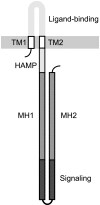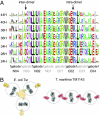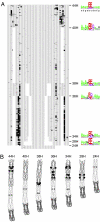Evolutionary genomics reveals conserved structural determinants of signaling and adaptation in microbial chemoreceptors
- PMID: 17299051
- PMCID: PMC1797150
- DOI: 10.1073/pnas.0609359104
Evolutionary genomics reveals conserved structural determinants of signaling and adaptation in microbial chemoreceptors
Abstract
As an important model for transmembrane signaling, methyl-accepting chemotaxis proteins (MCPs) have been extensively studied by using genetic, biochemical, and structural techniques. However, details of the molecular mechanism of signaling are still not well understood. The availability of genomic information for hundreds of species enables the identification of features in protein sequences that are conserved over long evolutionary distances and thus are critically important for function. We carried out a large-scale comparative genomic analysis of the MCP signaling and adaptation domain family and identified features that appear to be critical for receptor structure and function. Based on domain length and sequence conservation, we identified seven major MCP classes and three distinct structural regions within the cytoplasmic domain: signaling, methylation, and flexible bundle subdomains. The flexible bundle subdomain, not previously recognized in MCPs, is a conserved element that appears to be important for signal transduction. Remarkably, the N- and C-terminal helical arms of the cytoplasmic domain maintain symmetry in length and register despite dramatic variation, from 24 to 64 7-aa heptads in overall domain length. Loss of symmetry is observed in some MCPs, where it is concomitant with specific changes in the sensory module. Each major MCP class has a distinct pattern of predicted methylation sites that is well supported by experimental data. Our findings indicate that signaling and adaptation functions within the MCP cytoplasmic domain are tightly coupled, and that their coevolution has contributed to the significant diversity in chemotaxis mechanisms among different organisms.
Conflict of interest statement
The authors declare no conflict of interest.
Figures





Comment in
-
Ancient chemoreceptors retain their flexibility.Proc Natl Acad Sci U S A. 2007 Feb 20;104(8):2559-60. doi: 10.1073/pnas.0700278104. Epub 2007 Feb 14. Proc Natl Acad Sci U S A. 2007. PMID: 17301220 Free PMC article. No abstract available.
References
-
- Alon U, Surette MG, Barkai N, Leibler S. Nature. 1999;397:168–171. - PubMed
Publication types
MeSH terms
Substances
Grants and funding
LinkOut - more resources
Full Text Sources
Other Literature Sources
Molecular Biology Databases
Research Materials
Miscellaneous

